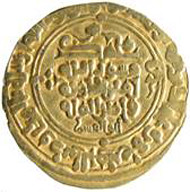
PREV ARTICLE
NEXT ARTICLE
FULL ISSUE
PREV FULL ISSUE
ONLINE SEMINAR ON ISLAMIC NUMISMATICS
On March 22 Coins weekly published this item announcing an online seminar on Islamic numismatics.
-Editor
Beginning on April 13, 2012 Professor Stefan Heidemann of Hamburg University will offer a seminar on Islamic Numismatics as a Source for Economic, Political and Art History of the Middle East. The web class will cover various topics of Islamic numismatics. Islamic coins are the most prolific epigraphic sources for pre 1500 history in the Middle East. Nevertheless their potential for understanding urban or regional history is often neglected, even in comparison to other material sources, such as ceramics and pottery, which usually get much more attention. This course is designed to introduce historians and archaeologists to the main issues of working with Islamic coins and coins finds.


Why are Islamic coins so important for history? For the period prior to the fifteenth century, historians of Islamic societies have almost no primary documents or archives at hand. In contrast to scarce primary documents, the secondary sources - literary and historical accounts especially from the ninth to the tenth century - are abundant. This gross imbalance between the primary documents, produced in the course of the events, and chronicles written much later, has led scholars to depend greatly upon medieval but secondary authors. Coins offer the often needed primary independent evidence produced in the course of events. Islamic coins as bearers of texts - there can be up to 150 words on one coin - are unique in the history of civilization. They are in fact a condensed form of text document which needs to be deciphered in various ways, serving different fields such as political, economic, industrial, social and legal, Islamic art and material culture, and metallurgy. As groups coins constitute a source of their own - such a sequence of coins from a single mint as historical narrative, as hoards and as archaeological coin finds form a single location they serve as a source for an economic and urban history. The class will explore topics such as
The web class explores these dimensions of the coins and coinages. The class will be held in English, via the internet. Registration in advance with the lecturer is mandatory for the preparation and setup of the equipment.
To read the complete article, see:
Islamic Numismatics online seminar at Hamburg University
(www.coinsweekly.com/en/News/4?&id=1097)
The Numismatic Bibliomania Society is a non-profit organization promoting numismatic literature. See our web site at coinbooks.org. To submit items for publication in The E-Sylum, write to the Editor at this address: whomren@gmail.com To subscribe go to: https://my.binhost.com/lists/listinfo/esylum All Rights Reserved. NBS Home Page Contact the NBS webmaster 
|